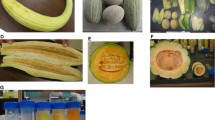Abstract
Sixty three cultigens from eight market types of the melon (Cucumis melo L. subsp. melo) groups Cantaloupensis and Inodorus were evaluated for ethylene production rate, shelf-life (postharvest decay), and RFLP polymorphisms. The ethylene production rates of melon fruits at maturity and (after) postharvest decay were measured on individual genotypes. The ethylene production rates of individual genotypes ranged from undetectable to 103 nl/g per h. The mean ethylene production rates of the eight market types, ranked from highest to lowest, were Eastern U.S. type, Charentais, Western U.S. type, Long Shelf-Life cantaloupes (LSL), Galia, Ananas, Honeydew, and Casaba. Ethylene production and postharvest decay rating were positively significantly correlated (r 2=0.87, P=0.05). Orange-fleshed melon fruits produced significantly (P=0.05) more ethylene than did green- or white-fleshed types. Melon fruits with a netted rind had significantly (P=0.05 for orange-flesh fruits and 0.01 for green- or white-flesh fruits) higher ethylene production than did smooth-type fruits. Using probes made from cDNAs encoding ACC oxidase (MEL1) or ACC synthase (MEACS1) genes, RFLPs were detected melon cultigens of the eight marker types showing varying ethylene production rates and different flesh colors. Low ethylene production and green- and white-flesh color were associated (r 2=0.91; P=0.05) with the presence of a putative RFLP-MEL1 allele A 0 (15-kb), whereas high ethylene production and orange-flesh color were associated with allele B 0 (8.5-kb) in the homozygous condition, after probing MEL1 with EcoRV-digested genomic DNA. Also, after probing MEACS1 with NdeI-digested genomic DNA, RFLP polymorphism revealed five fragments denoted as A, B, C, D and E, with molecular sizes of 5.2-, 4.2-, 3.8-, 3.0- and 1.0-kb, respectively. A two-fragment pattern, AB, and a three-fragment pattern, ACE, the two predominant RFLP patterns, were also associated with low and high ethylene production, respectively. The ACE fragment pattern was also associated with orange-flesh melons. Scoring of both probes allowed for the unique classification of most melon market types consistent with ethylene production and the postharvest decay phenotypes. Therefore, these RFLPs might have utility in marker-assisted selection for the development of melons with enhanced postharvest keeping ability.
Similar content being viewed by others
Author information
Authors and Affiliations
Additional information
Received: 26 March 1998 / Accepted: 12 January 2000
Rights and permissions
About this article
Cite this article
Zheng, X., Wolff, D. Ethylene production, shelf-life and evidence of RFLP polymorphisms linked to ethylene genes in melon (Cucumis melo L.). Theor Appl Genet 101, 613–624 (2000). https://doi.org/10.1007/s001220051523
Issue Date:
DOI: https://doi.org/10.1007/s001220051523




